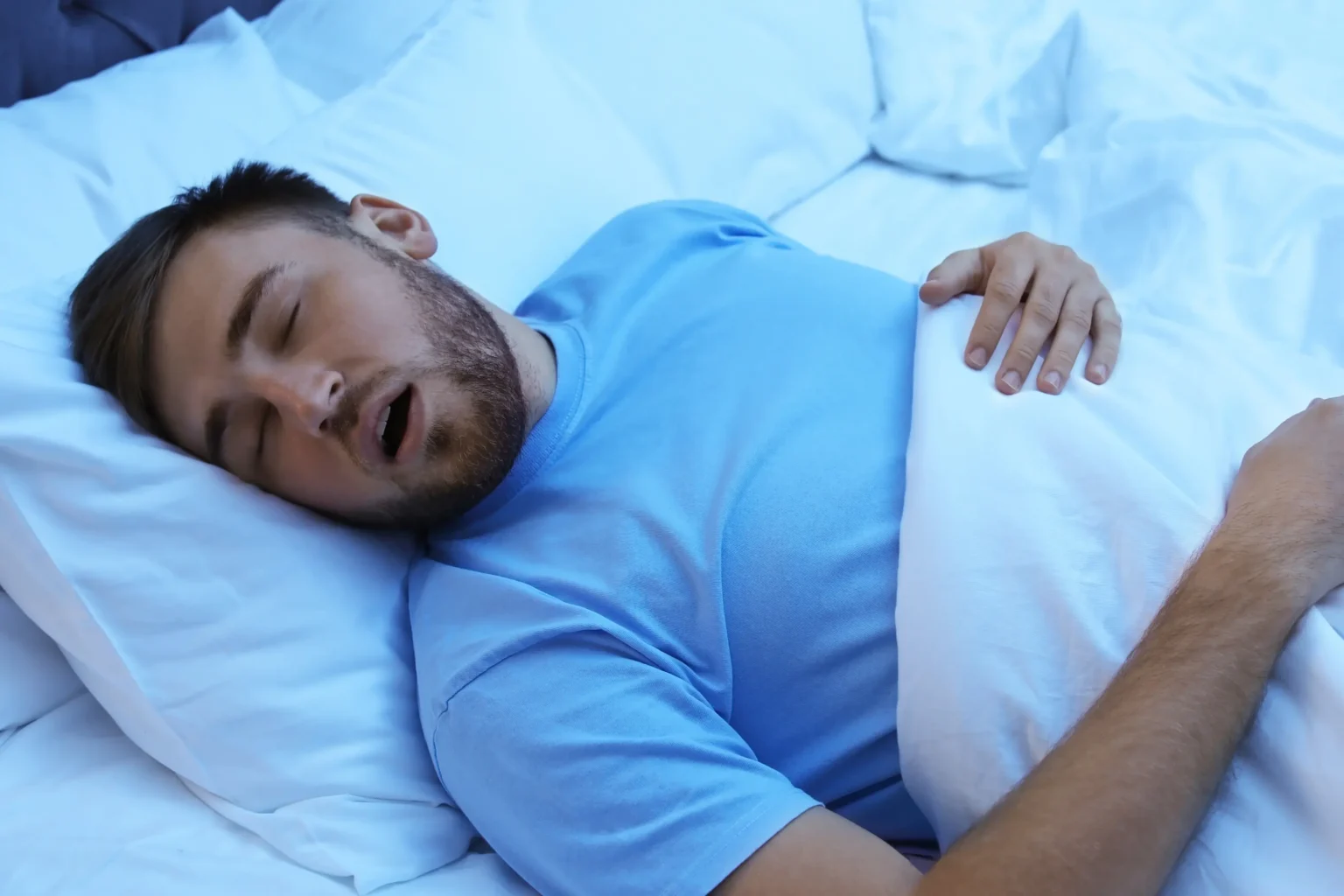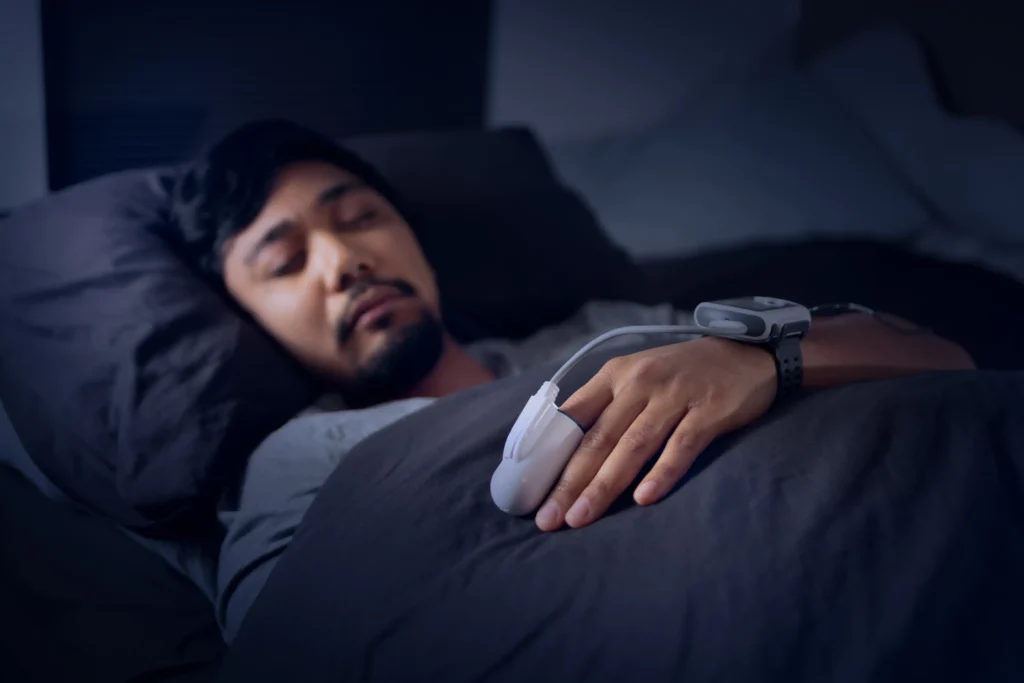Snoring
Discover the underlying cause and severity of your snoring.
Request An AppointmentRefer A Patient
What is Snoring?
Table Of Contents
Causes of Snoring
Several factors can contribute to snoring, including:
- Anatomy of the Airway: A narrow airway, enlarged tonsils, or a thick soft palate can obstruct airflow.
- Nasal Congestion: Allergies, sinus infections, or a deviated septum can make breathing through the nose difficult.
- Obesity: Excess weight around the neck can put pressure on the airway.
- Sleeping Position: Sleeping on the back may cause the tongue to fall backward, partially blocking the airway.
- Alcohol and Sedatives: These substances relax throat muscles, increasing the likelihood of airway obstruction.
- Sleep Apnea: Snoring can indicate obstructive sleep apnea (OSA), a condition where breathing repeatedly stops and starts during sleep.

Health Risks Associated
with Snoring
Persistent snoring may lead to or indicate serious health concerns, such as:
- Obstructive Sleep Apnea (OSA): A condition that disrupts normal breathing patterns and reduces oxygen levels.
- Daytime Fatigue: Poor sleep quality due to frequent awakenings can cause excessive daytime sleepiness.
- Cardiovascular Issues: Untreated sleep apnea and severe snoring have been linked to high blood pressure, heart disease, and stroke.
- Cognitive Impairment: Sleep disruption may contribute to memory issues and difficulty concentrating.
When to Seek Medical Attention
Occasional snoring may not require treatment, but medical evaluation is recommended if snoring is accompanied by:
- Gasping or choking sounds during sleep
- Pauses in breathing
- Excessive daytime sleepiness
- Morning headaches or dry mouth
- Difficulty concentrating or mood changes
Diagnosis and Evaluation
When it comes to diagnosing and evaluating snoring, a sleep specialist is your best ally. They may recommend a home sleep apnea test (HSAT) or an in-lab sleep study (polysomnogram) to assess breathing patterns, oxygen levels, and sleep disruptions. A physical examination by a specialist can also help identify anatomical causes of snoring.
Treatment Options for Snoring
Treatment depends on the underlying cause and severity of snoring. Options may include:
Lifestyle Changes
- Weight Management: Losing excess weight can reduce airway obstruction.
- Positional Therapy: Sleeping on the side instead of the back can minimize airway blockage.
- Nasal Decongestion: Treating allergies or using nasal strips may improve airflow.
- Avoiding Alcohol and Sedatives: Reducing intake before bedtime can prevent excessive muscle relaxation.
Medical and Surgical Treatments
- Continuous Positive Airway Pressure (CPAP): A CPAP machine delivers a steady stream of air to keep the airway open and is, often used for obstructive sleep apnea.
- Bi-level Positive Airway Pressure (BiPAP): Provides different pressure settings for inhalation and exhalation, offering an alternative for those who struggle with CPAP.
- Automatic Positive Airway Pressure (APAP): Adjusts air pressure throughout the night based on breathing needs.
- Oral Appliances: Custom-fitted devices reposition the lower jaw and tongue to keep the airway open.
- Surgical Options: Procedures such as uvulopalatopharyngoplasty (UPPP), radiofrequency ablation, or nasal surgery may be considered for structural issues.
Frequently Asked Questions
0
Is snoring always a sign of sleep apnea?
Not always. While snoring is a common symptom of sleep apnea, many individuals snore without having the condition. A sleep study can help determine whether sleep apnea is present.
0
Can snoring be treated without CPAP?
Yes. Lifestyle changes, oral appliances, and positional therapy can help reduce snoring. However, if sleep apnea is diagnosed, CPAP may be the most effective treatment.
0
How can snoring be reduced naturally?
Weight loss, avoiding alcohol before bed, nasal decongestion, and sleeping on the side can help minimize snoring.
0
When should snoring be a concern?
Snoring that is loud, frequent, or associated with breathing pauses, choking, or excessive daytime sleepiness should be evaluated by a sleep specialist.
0
What happens during a sleep study?
A sleep study monitors breathing, oxygen levels, and body movements to assess for snoring-related conditions like sleep apnea. It can be done at home (home sleep apnea test) or in a sleep lab (polysomnography).

